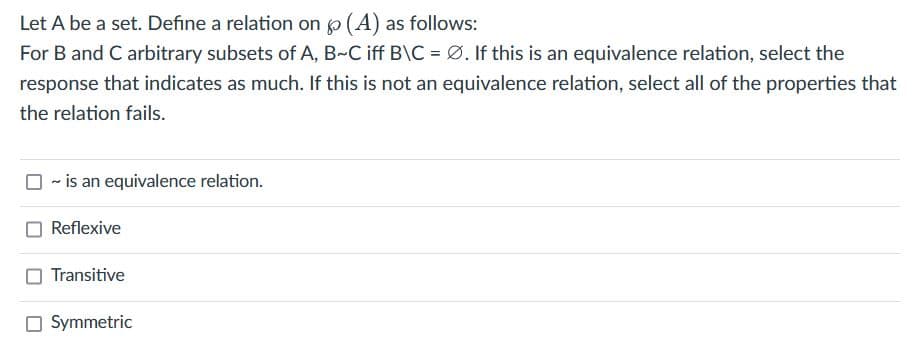Let A be a set. Define a relation on (A) as follows: For B and C arbitrary subsets of A, B-C iff B\C = Ø. If this is an equivalence relation, select the response that indicates as much. If this is not an equivalence relation, select all of the properties that the relation fails. → is an equivalence relation. Reflexive Transitive Symmetric
Let A be a set. Define a relation on (A) as follows: For B and C arbitrary subsets of A, B-C iff B\C = Ø. If this is an equivalence relation, select the response that indicates as much. If this is not an equivalence relation, select all of the properties that the relation fails. → is an equivalence relation. Reflexive Transitive Symmetric
Elements Of Modern Algebra
8th Edition
ISBN:9781285463230
Author:Gilbert, Linda, Jimmie
Publisher:Gilbert, Linda, Jimmie
Chapter1: Fundamentals
Section1.7: Relations
Problem 3E: a. Let R be the equivalence relation defined on Z in Example 2, and write out the elements of the...
Related questions
Question
Need help with this Foundations of Mathematics homework problem. Put a check mark next to the correct answers.

Transcribed Image Text:Let A be a set. Define a relation on (A) as follows:
For B and C arbitrary subsets of A, B-C iff B\C = Ø. If this is an equivalence relation, select the
response that indicates as much. If this is not an equivalence relation, select all of the properties that
the relation fails.
~ is an equivalence relation.
Reflexive
Transitive
Symmetric
Expert Solution
This question has been solved!
Explore an expertly crafted, step-by-step solution for a thorough understanding of key concepts.
Step by step
Solved in 3 steps with 3 images

Recommended textbooks for you

Elements Of Modern Algebra
Algebra
ISBN:
9781285463230
Author:
Gilbert, Linda, Jimmie
Publisher:
Cengage Learning,

Elements Of Modern Algebra
Algebra
ISBN:
9781285463230
Author:
Gilbert, Linda, Jimmie
Publisher:
Cengage Learning,